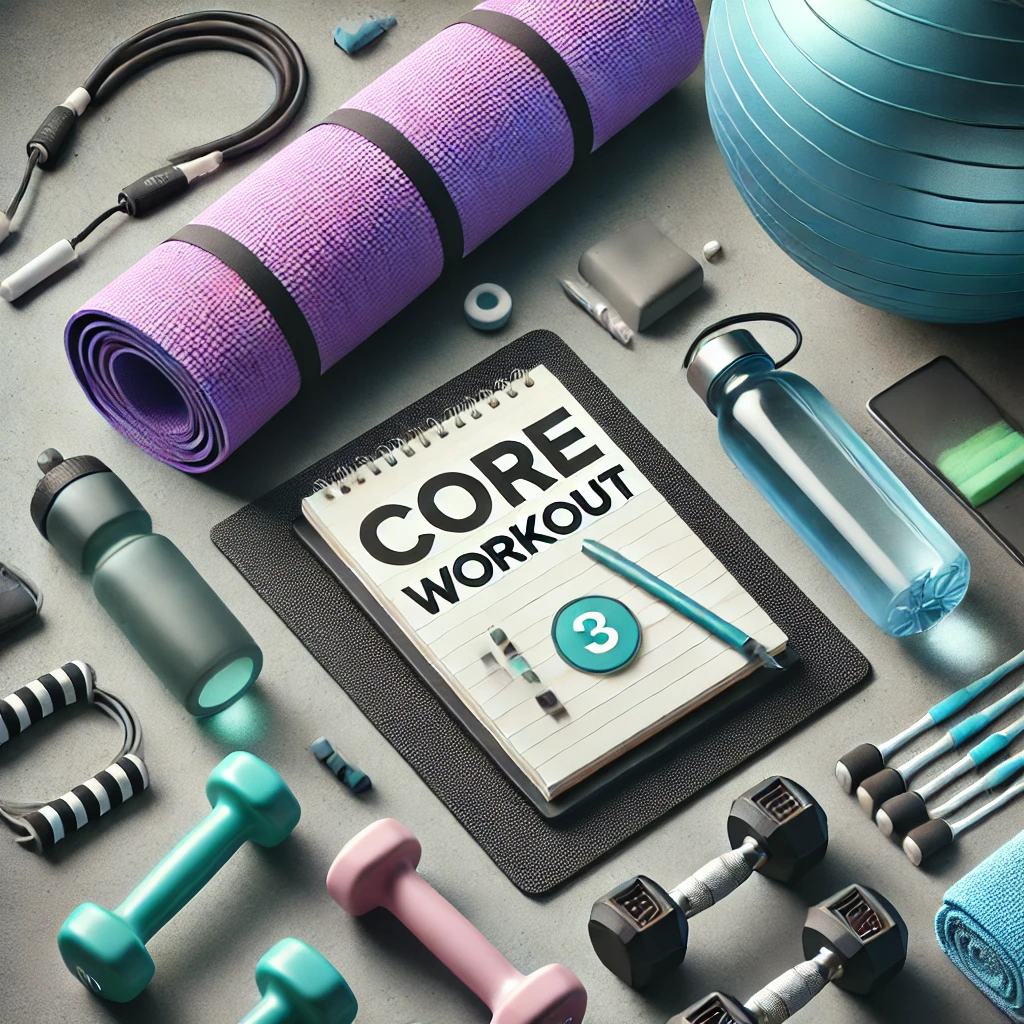18 Core Exercises for Beginners: Build a Strong Foundation
A strong core is essential for overall fitness, balance, and stability. Whether you’re just starting your fitness journey or looking to strengthen your foundation, these core exercises are perfect for beginners. In this guide, we’ll explore 18 effective exercises that target various core muscles, helping you improve posture, prevent injuries, and boost workout performance.
1. What is the Core? Understanding the Basics
The core includes not just the abs, but a range of muscles that support the body’s trunk. Key muscles in the core include:
- Rectus Abdominis: Often called the “six-pack” muscles, these are visible at the front.
- Obliques: Located along the sides, these muscles help with twisting movements.
- Transverse Abdominis: A deep muscle that provides stability to the spine.
- Lower Back Muscles: Supports the back and plays a role in core stability.
Fact: A strong core isn’t only about aesthetics; it’s essential for supporting daily movements and protecting your back.
Tip: Start with simple exercises to activate all parts of the core, even if you’re focused on getting toned abs.
2. Why Beginners Should Focus on Core Exercises
For beginners, building core strength is critical to prevent injuries and improve overall body coordination. Core exercises can also enhance balance, making it easier to perform other types of workouts safely.
2.1. Benefits of Core Exercises for Beginners
- Improves Posture: A strong core helps maintain good posture.
- Reduces Lower Back Pain: A stronger core means less strain on the back.
- Boosts Confidence: Feeling stable and balanced improves overall fitness confidence.
Example: Even simple tasks like bending over or lifting a bag become easier with a strong core.
3. 18 Core Exercises for Beginners
Let’s dive into 18 beginner-friendly core exercises. Each one is designed to strengthen different areas of the core, with variations to match your fitness level.
4. Basic Core Exercises for Absolute Beginners
If you’re new to working out, start with these basic core exercises to activate and strengthen your core gently.
4.1. Plank (Beginner Version)
- How to Do It: Lie face down, lift your body up on your forearms and toes, keeping a straight line from head to toe. Hold for 15–30 seconds.
- Benefits: Strengthens the entire core, especially the transverse abdominis.
- Tip: Start with shorter holds and work your way up as you get stronger.
4.2. Glute Bridge
- How to Do It: Lie on your back with knees bent, feet flat. Lift your hips up, squeezing your glutes and engaging your core, then lower.
- Benefits: Strengthens lower back, glutes, and engages the core.
- Fact: Glute bridges also help improve lower body stability.
4.3. Dead Bug
- How to Do It: Lie on your back, extend your arms straight up, and bend your knees at 90 degrees. Lower one arm and the opposite leg toward the floor, then return to start. Repeat on the other side.
- Benefits: Builds coordination and activates the lower abs.
- Tip: Move slowly to maintain control and maximize the exercise’s effectiveness.
5. Intermediate Core Exercises for Increased Engagement
Once you’re comfortable with the basics, move on to these intermediate exercises to challenge your core further.
5.1. Russian Twist (Bodyweight)
- How to Do It: Sit on the floor, knees bent. Lean back slightly, twist your torso to the left, then right, keeping your core tight.
- Benefits: Engages obliques and strengthens rotational movements.
- Tip: For an extra challenge, hold a light weight or water bottle as you twist.
5.2. Bird Dog
- How to Do It: Get on all fours. Extend your right arm and left leg out straight, then return to start. Switch sides.
- Benefits: Enhances balance and stability while working the core.
- Fact: Bird Dog is often used in physical therapy to improve coordination and strengthen the core.
5.3. Mountain Climbers
- How to Do It: Get into a plank position, then drive one knee towards your chest, switch legs, and continue at a moderate pace.
- Benefits: Increases heart rate while working core, legs, and arms.
- Tip: Focus on form rather than speed, especially when starting out.
5.4. Seated Leg Raises
- How to Do It: Sit on the floor, lean back slightly with hands behind you, and lift your legs up to engage your lower abs.
- Benefits: Targets lower abs and hip flexors.
- Example: This exercise is effective for building lower abdominal strength without needing equipment.
6. Advanced Beginner Core Exercises for Greater Challenge
These advanced beginner exercises offer a bit more challenge and are ideal once you feel confident with the intermediate exercises.
6.1. Bicycle Crunches
- How to Do It: Lie on your back, place hands behind your head, and bring one knee toward your chest as you twist your opposite elbow towards it. Alternate sides.
- Benefits: Targets both the upper abs and obliques.
- Fact: Bicycle crunches engage more muscle groups than traditional crunches, making them more effective.
6.2. Reverse Crunch
- How to Do It: Lie on your back, lift your legs up to 90 degrees, and bring your knees towards your chest by lifting your hips off the floor.
- Benefits: Engages lower abs effectively.
- Tip: Move slowly to avoid using momentum, focusing instead on core engagement.
6.3. Heel Touches
- How to Do It: Lie on your back, knees bent and feet flat. Reach one hand toward the heel of the same side, then alternate sides.
- Benefits: Works the obliques and helps shape the waistline.
- Tip: Keep your back flat on the ground for optimal engagement.
7. Core Exercises to Support Full-Body Movements
Some exercises not only strengthen the core but also help with balance and stability for better performance in everyday activities.
7.1. Side Plank (Beginner Version)
- How to Do It: Lie on your side, prop yourself up on one elbow, and lift your hips off the ground to create a straight line from head to toe. Hold for 15–30 seconds.
- Benefits: Works the obliques and improves side core stability.
- Example: Side planks are great for stabilizing the core, which helps prevent injuries.
7.2. Superman Pose
- How to Do It: Lie face down, extend arms and legs, then lift them off the ground simultaneously, keeping the back and core tight.
- Benefits: Strengthens lower back muscles, part of the core.
- Fact: Superman is beneficial for countering the effects of prolonged sitting by activating the back muscles.
7.3. Standing Oblique Crunch
- How to Do It: Stand with hands behind your head, lift one knee to the side, bringing it toward your elbow on the same side. Switch sides.
- Benefits: Targets obliques while improving balance.
- Tip: Focus on squeezing your side muscles as you bring your knee and elbow together.
8. More Core Exercises for Full-Body Stability
For a balanced approach to core strength, these exercises help with stability, coordination, and strengthening deeper muscles essential for full-body support.
8.1. Toe Taps
- How to Do It: Lie on your back with knees bent at 90 degrees, and tap each toe down one at a time. Keep your core tight throughout.
- Benefits: Focuses on the lower abs, building control and stability.
- Tip: Move slowly and engage the core to prevent lower back strain.
8.2. Single-Leg Jackknife
- How to Do It: Lie on your back with arms extended overhead and legs straight. Lift one leg and reach the opposite arm to meet it, then switch.
- Benefits: Works both the abs and hip flexors, and improves coordination.
- Fact: The single-leg jackknife is more accessible for beginners and helps develop core strength progressively.
8.3. Lying Leg Raise
- How to Do It: Lie flat with your hands at your sides, lift your legs to 90 degrees, and slowly lower them back down.
- Benefits: Targets the lower abs and hip flexors.
- Example: Many beginners find lying leg raises effective for lower abs without putting pressure on the spine.
9. Core Exercises with a Twist: Adding a Bit More Challenge
These slightly more challenging exercises introduce new movements that target the core with a twist, providing even more engagement.
9.1. Standing Wood Chop
- How to Do It: Stand with feet shoulder-width apart, clasp hands, and twist from one side to the other in a chopping motion. Engage the core throughout.
- Benefits: Targets obliques and helps build rotational strength.
- Tip: Start without weights to practice form, then add a small weight when comfortable.
9.2. Climber Taps
- How to Do It: Get into a plank position and tap each hand on the opposite shoulder while engaging your core.
- Benefits: Engages both the core and shoulder muscles, helping improve balance and stability.
- Fact: This exercise is similar to mountain climbers but with added focus on core stability.
9.3. Flutter Kicks
- How to Do It: Lie on your back, lift your legs slightly off the ground, and kick them up and down alternately.
- Benefits: Engages the lower abs and builds endurance.
- Example: Flutter kicks can be combined with other exercises for a high-energy core workout.
10. Putting it All Together: A Sample Beginner Core Workout Routine
Here’s a sample routine combining these exercises for a full core workout. You can adjust the repetitions and sets based on your fitness level.
- Warm-Up: Start with 5 minutes of light cardio, like jumping jacks or brisk walking.
- Plank: 2 sets of 20 seconds
- Dead Bug: 2 sets of 12 reps (6 on each side)
- Glute Bridge: 2 sets of 15 reps
- Russian Twist: 2 sets of 10 reps (5 on each side)
- Bird Dog: 2 sets of 10 reps (5 on each side)
- Toe Taps: 2 sets of 12 reps (6 on each leg)
- Cool Down: Stretch for 5 minutes, focusing on the core and lower back.
Tip: Start with once or twice a week, then gradually increase to three sessions per week as you feel more comfortable with the exercises.
11. Tips for Building Core Strength Safely
- Consistency is Key: For visible improvements, aim to incorporate core exercises consistently over time.
- Progress at Your Own Pace: Avoid rushing into advanced exercises. Focus on good form for maximum effectiveness and safety.
- Breath Control: Remember to breathe naturally throughout the exercises. Exhale as you exert effort, and inhale as you release.
Fact: Studies show that performing core exercises with controlled breathing can enhance muscle engagement and reduce the risk of strain.
12. Frequently Asked Questions (FAQs) About Core Exercises for Beginners
12.1. How Often Should I Do Core Exercises?
Begin with 2-3 times per week, allowing at least one day of rest between core-focused workouts.
12.2. Do Core Exercises Burn Belly Fat?
Core exercises strengthen and tone muscles but do not specifically target fat loss. For fat loss, a combination of cardio, a balanced diet, and full-body strength training is recommended.
12.3. Can Core Exercises Help with Lower Back Pain?
Yes, core exercises strengthen the muscles around the lower back, which can help reduce strain and alleviate pain. Start with beginner-friendly exercises like the glute bridge and bird dog to avoid aggravating back issues.
13. Final Thoughts: The Importance of Core Strength for Beginners
A strong core provides the foundation for nearly every movement we make. From lifting groceries to improving posture, core strength impacts our daily lives more than we realize. Incorporate these beginner-friendly exercises into your routine, progress gradually, and enjoy the benefits of a stable, balanced body.
Pro Tip: Keep your workouts interesting by mixing up the exercises each session, ensuring you engage all parts of your core and make steady progress.




